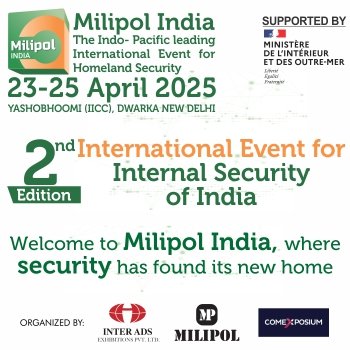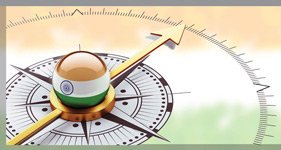History is perhaps the most contested discipline in the realm of social sciences. Every word, every letter, every feeling is contested and that too vigorously. The process of writing on history itself is even more contentious. The adage, “The Victor writes history” has contributed to the shaping of the culture, politics, and institutions of several societies across the nook and corner of the planet. India, in that context, was and still is a battleground of contesting and conflictual ideas about its origin, past and most significant of all-her identity.
The process of writing history is essentially a practice of narrative setting in the history of ideas. Narratives define not just the base of the culture but also sets the stage for interaction among endogenous and exogenous forces. India has seen, ever since the beginning of the Indic Renaissance during the period of European colonisation of India, a fierce contest for her identity. The million-dollar question that arises in the annals of history writing is this-what is India?
To provide a concrete and somewhat non-controversial answer to the question noted Scottish historian, author, podcaster William Dalrymple has written a new book titled The Golden Road-How Ancient India Transformed the World which is a masterpiece of scholarly work. The noted historian who is the author of over a dozen books is an authoritative voice on Indology i.e., the history of India’s past and aspects covering her identity which spans several aspects of her culture.
The book is composed of ten chapters, each covering a separate facet of India’s past, especially the ancient past of our country. The book begins with the author paying a glorious tribute to the wonder called India; Dalrymple who has lived in India for close to four decades is quite well aware of the nuances of Indic history that the book intends to highlight.
The introductory part tried to set the record straight that what is called today as the ‘Silk Road’ was essentially a term that came much later, it was a term coined by a German geographer Ferdinand Von Richtofen in 1877 when he was on an exploratory mission to China. However, the idea of Golden Road is what existed since times immemorial.
The process of writing history is essentially a practice of narrative setting in the history of ideas. Narratives define not just the base of the culture but also sets the stage for interaction among endogenous and exogenous forces
Dalrymple states that the Golden Road or the Indosphere is a network of maritime and continental routes straddling across several countries in Asia, Europe, and the Middle East. It is essentially a network that highlights the expansive sphere of Indian influence-from customs, traditions, cuisine, philosophy, astronomy, sciences etc., that were exported to countries like China and regions like South East Asia most prominently in the ancient world which highlighted how India managed to carve a distinct sphere of influence using ideas.
The book delves on different themes. The first part focuses on how India in the ancient times had a thriving trade relationship with the Roman Empire (the western part of the Empire before its vivisection in 395 AD). Indian metals, especially gold was in much demand in the Roman Empire, other commodities such as spices, cash crops like cotton, and muslin accounted for a substantial chunk of Indian exports to the Roman Empire. The volume of trade was so high and was so much in India’s favour that Roman historians literally complained about the drain of wealth from Rome to Delhi.
A key point of focus in this aspect was the importance of maritime ports. Ports like Tamralipti in Bengal, Arikamedu in Tamil Nadu etc., where Roman coins, especially gold have been found in substantial quantities, indicate the depth of India’s ties with the West at that time.
Dalrymple states that the Golden Road or the Indosphere is a network of maritime and continental routes straddling across several countries in Asia, Europe, and the Middle East. It is essentially a network that highlights the expansive sphere of Indian influence-from customs, traditions, cuisine, philosophy, astronomy, sciences etc., that were exported to countries like China and regions like South East Asia most prominently in the ancient world which highlighted how India managed to carve a distinct sphere of influence using ideas
A crucial theme of the book has been the Hindu and Buddhist connections that India forged with China and almost the whole of South East Asia. Buddhism which originated during the period of the Mahajanpads was founded by Siddharta Gautama-a royal prince belonging to the Shakya clan in the royal family of Nepal.
It was the trials and tribulations of his life, especially the suffering that he saw around him despite fervent attempts on the part of his family to keep him away from such ‘sights’, which alienated him from the household, he left his family and crown at the age of 29 and became a wandering ascetic. Over time through austere penance and meditation, he became the Buddha or the ‘Enlightened one’. He delivered his first sermon at Sarnath which came to be known as ‘Dharmachakrapravartan’. Thus, Buddhism was born-the new religion soon attracted ubiquitous number of followers owing to the simplicity of the faith and a practical way to answer the most important objective of life-liberation from the cycle of birth and rebirth.
Over time, Dalrymple highlighted, the religion spread. The watershed moment in the history of Buddhism in general and the history of Bharat in particular was the ascent to power of Ashoka. He was perhaps the greatest Buddhist as well as the greatest cultural ambassador in Indian history.
The book delves on different themes. The first part focuses on how India in the ancient times had a thriving trade relationship with the Roman Empire (the western part of the Empire before its vivisection in 395 AD). Indian metals, especially gold was in much demand in the Roman Empire, other commodities such as spices, cash crops like cotton, and muslin accounted for a substantial chunk of Indian exports to the Roman Empire
He is known, Dalrymple argues for the erection of stupas on a massive scale and for his rock and pillar edicts wherein he maintained a direct contact with his subjects. He was the first global ruler to do so. He appointed Dhamma Mahattmas to spread the idea of Dhamma or the idea of doing one’s duty properly, based on the teachings of Buddha. He maintained contacts with foreign rulers to spread the message of Dhamma and even dispatched his children to Ceylon and other parts of Asia to spread the message of Buddha.
A key part of the book is dedicated to the role of travellers in spreading India’s Buddhist knowledge far and wide. Dalrymple has written at length about Xuanzang and the perils he faced while trying to come to India to study at the famed Nalanda University which was the undisputed seat of learning of the globe at that time. This brings us to another key part of the book-the role of the Nalanda University.
The university was set up, notes Dalrymple in the early 6th century by Kumaragupta, the last effective ruler of the Gupta Empire, who presided over the golden age of Indic history. For well over five centuries, the university remained the intellectual centre of the Asian world earning India, the title of the global intellectual capital only to meet a tragic fate-it was burnt to the ground by the iconoclastic Turkic general and conquer Muhammed Bin Bakhtiyar Khilji in 1202 CE.
A key aspect of the book is how the Indosphere included, within its ambit, the Chinese and South East Asian regions. China, ironically became the bastion of Buddhist heritage and culture, when it was in decline in India, thanks to the rise of a Puranic Hinduism under the Guptas
A key aspect of the book is how the Indosphere included, within its ambit, the Chinese and South East Asian regions. China, ironically became the bastion of Buddhist heritage and culture, when it was in decline in India, thanks to the rise of a Puranic Hinduism under the Guptas. Dalrymple writes at length about the role of the first and one of the most powerful monarchs of China Wu Zetian’s role in not only making Buddhism the state religion of the country but also internalising the Indic influence into China.
He was full of praise for her, especially her intellectual activities and architectural projects which glorified Buddhism in all its beauty. Related to that, Dalrymple highlighted in the later parts of his book, the enduring influence exerted by Buddhism on South East Asia.

The Buddhist influence spanned almost the entirety of South East Asia. In this context Dalrymple went on to focus the role of the Srivijaya Empire of Indonesia, Khmer Empire in Cambodia, and their intellectual and artistic pursuits. He laid special focus on the architectural beauty of Borodur which is the largest Buddhist complex in the world.
A key feature of the book is its focus on India’s Hindu past. Dalrymple paid a fitting tribute to the intellectual prowess of Hinduism. He went on to describe, in detail, the advanced nature of Hindu science, philosophy, mathematics, astrology etc., He paid special attention to the role of the Gupta Empire which saw, according to the author, the flourishing of India’s intellectual superiority in almost all fields.
He specially praises the role of Sanskrit-described as the language of the Gods, which was the undisputed official language of different Hindu empires and kingdoms for over two millennia, before the advent of Islamic rule in India. He pays special attention to the roles of Aryabhatta, Brahmagupta, Kalidasa, Dandini etc., in developing not just the Indo-Arabic numeral system but also other scientific and literary inventions.
Dalrymple also dedicates a large section of the book to the history of South India, highlighting the rule of Pallavas, Cholas and some other prominent dynastic kingdoms. He went on to give an in-depth description of temple architecture of India. He delves into the naval achievements of Cholas, especially their conquest of Indonesia, Maldives etc.
He also dedicates a large section of the book to the history of South India, highlighting the rule of Pallavas, Cholas and some other prominent dynastic kingdoms. He went on to give an in-depth description of temple architecture of India. He delves into the naval achievements of Cholas, especially their conquest of Indonesia, Maldives etc.
Dalrymple also focuses on the impact of India’s relationship with West Asia or the Muslim world. He highlights the importance of Indian science, mathematics, philosophy etc., on the Abbasid caliphate and how it managed to catch the eye of several caliphs such as Al-Mamun, Harun Al Rashid etc., In this, highlights the distinct contribution of the Barmakid dynasty who were the viziers of several Abbasid caliphs.
However, as happens with all books on history, Dalrymple also writes on the grim period of Islamic rule in India, particularly the Turkic invasions of Mahmud of Ghazni, Mohammed Ghori on one hand and the marauding Mongol raids throughout Asia on the other hand to underscore how these events not only put an end to the Golden Road, but unfortunately ended up neutralising the Indosphere. This resulted in the shifting of attention to the European continent, which the author notes, used India’s inventions and contributions to not only not prosper but ended up using their military and economic superiority to colonise large parts of the world, particularly India.
Dalrymple concludes that India’s spirit is at its best when it is plural, inclusive and its ideas flourish when they come from multiple sources. Needless to say, the book is one of the most fulfilling reads on India’s past
The author concludes that India’s spirit is at its best when it is plural, inclusive and its ideas flourish when they come from multiple sources. Needless to say, the book is one of the most fulfilling reads on India’s past.
–The writer is currently working as a Research Associate at Defence Research and Studies (dras.in) and is a columnist. The views expressed are personal and do not necessarily reflect the views of Raksha Anirveda

















